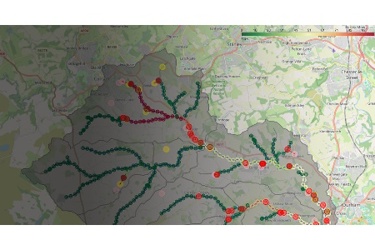River Deep Mountain AI Releases First Open-Source Models

Collaborative innovation project River Deep Mountain AI (RDMAI) has announced the open-source release of a suite of artificial intelligence and machine learning (AI/ML) models set to transform the way water quality data is collected and used.
Funded by Ofwat’s Water Breakthrough Challenge and led by Northumbrian Water, with Spring Innovation as the knowledge-sharing partner, RDMAI is a cross-sector initiative building open-source, scalable AI tools to tackle waterbody pollution and improve river health. Data from a range of sources, including citizen science and satellites, has been used to build the models.
The release of AI/ML and remote-sensing models on the open-source platform GitHub is the project’s first major milestone, following completion of the development and initial testing phases. Throughout this period, the project team collated datasets from within and outside the sector, run experiments with AI/ML models and held co-creation sessions with partners and stakeholders.
The resulting models and datasets aim to support:
- River flow predictions
- Pollution source tracking
- Pollution hotspot mapping
Feedback is invited at this stage to help refine and enhance the models as the project progresses.
The UK’s water environment is under pressure from population growth, climate change, pollution from multiple sources and nutrient overload. Just 14% of English rivers are meeting Water Framework Directive standards for good ecological status.
Launched in July 2024, River Deep Mountain AI aims to address this challenge by developing open-source, scalable AI/ML models to uncover pollution patterns and unlock actionable insights for protecting waterbodies.
Northumbrian Water’s project partners are: ADAS, Anglian Water, Cognizant, Northern Ireland Water, South West Water, Stream, The Rivers Trust, Google, WRc, Wessex Water and Xylem.
George Gerring, project lead, Northumbrian Water, said, “We have built a set of capabilities that use artificial intelligence, machine learning, generative AI and remote sensing to understand and predict different variables impacting waterbodies health.
“The open-source release of these models on GitHub means they are available for citizens, researchers, water organisations and NGOs to use. Any feedback on the early releases will help us refine and build on what we’ve achieved so far.”
Angela MacOscar, head of innovation, Northumbrian Water, said: “Useable data on waterbody health is disparate and hard to access, which is why the RDMAI team is working to squeeze as much actionable information out of existing data as possible.
“By integrating data from various sources, including environmental sensors, satellite imagery and citizen science, the project is bridging the data gaps in waterbody health and empowering better, faster and more effective interventions. Open-sourcing these models marks a major shift in how we collaborate to tackle environmental challenges.”
Stig Martin, global head of ocean, Cognizant, said: “This project is a testament to the power of research and development and daring to use technology to solve complex, large-scale environmental problems.
“We believe in transparency and are proud that this project is open-source, allowing everyone to see how the system is built and how it generates its insights. It has been incredibly rewarding to be part of a collaboration that is not just talking about change but is actively building the tools to make it happen.”
Phase three of the programme, now underway, will focus on model improvement, validation in new catchments and evaluating the potential to scale across the UK. The refined versions of the models are set to be released in November.
The GitHub page for RDMAI can be viewed at https://github.com/Cognizant-RDMAI.
Source: Spring Innovation
